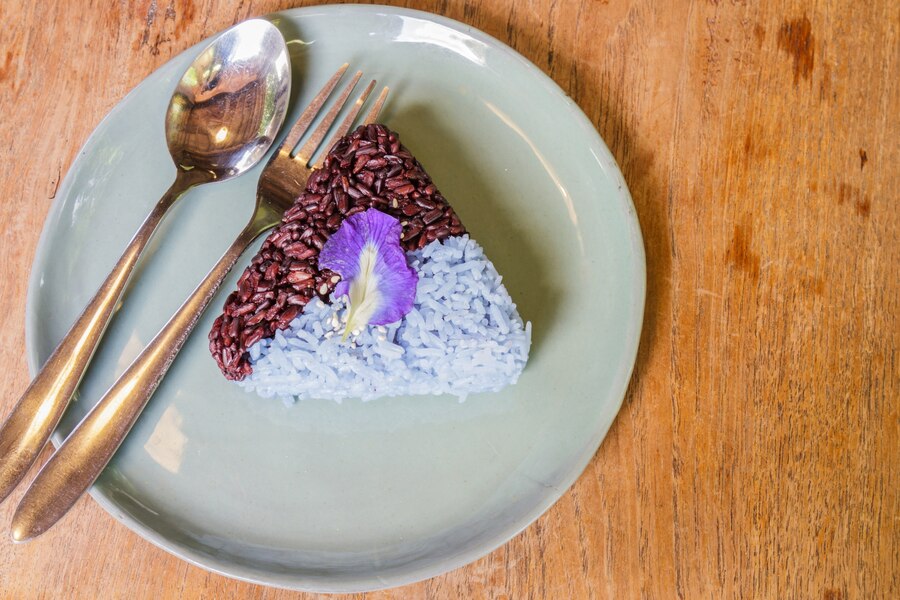Purple Rice vs. White Rice – Discover the Health Benefits
When it comes to making healthier choices in your diet, rice often becomes a topic of discussion. Traditionally, white rice has been a staple in many households, but there’s a new contender on the block: purple rice. I discovered purple rice while exploring different whole grains to include in my diet, and its numerous health benefits immediately caught my attention. Let me share why purple rice is a superior option compared to white rice and how it can contribute to better health.
Nutritional Superiority of Purple Rice
Purple rice, also known as black rice or forbidden rice, is a type of whole grain that is packed with nutrients. Unlike white rice, which is milled and stripped of its bran and germ layers, purple rice retains all parts of the grain, making it much more nutritious.
1. High in Antioxidants
One of the most significant advantages of purple rice is its high antioxidant content. The deep purple color comes from anthocyanins, the same powerful antioxidants found in blueberries and red cabbage. These antioxidants help combat oxidative stress in the body, which can lead to chronic diseases such as heart disease, diabetes, and cancer.
Preparation & Quantity: To incorporate purple rice into your meals, cook it as you would with any other rice, using one part rice to two parts water. A serving size is typically 1/4 cup of uncooked rice per person.
Suggestive Product: Organic Tattva Black Rice on Amazon India
2. Rich in Fiber
Purple rice is also high in dietary fiber, which is essential for maintaining a healthy digestive system. The fiber in purple rice helps regulate bowel movements, lowers cholesterol levels, and can aid in weight management by promoting a feeling of fullness.
In comparison, white rice is low in fiber due to the removal of the bran during processing. This makes purple rice a much better option for those looking to improve their digestive health and control their weight.
Preparation & Quantity: When preparing a meal, consider swapping out your white rice for purple rice to increase your fiber intake. A cup of cooked purple rice provides about 2-3 grams of fiber.
3. Lower Glycemic Index
For those managing blood sugar levels, the glycemic index (GI) of food is an important consideration. Purple rice has a lower glycemic index than white rice, meaning it causes a slower, steadier rise in blood sugar levels. This makes it a healthier choice for people with diabetes or anyone trying to prevent blood sugar spikes.
White rice, on the other hand, has a high glycemic index, which can lead to rapid increases in blood sugar and insulin levels. This difference makes purple rice a better option for sustained energy and blood sugar control.
Preparation & Quantity: Incorporate purple rice into your daily meals to maintain steady blood sugar levels, especially if you’re diabetic or insulin-resistant.
4. Packed with Vitamins and Minerals
Purple rice is a good source of essential vitamins and minerals, including vitamin E, iron, and zinc. These nutrients play a critical role in various bodily functions, such as boosting the immune system, supporting skin health, and aiding in the formation of red blood cells.
White rice, while fortified with some vitamins, does not naturally contain the same nutrient density as purple rice. Consuming purple rice regularly can help ensure you’re getting a more comprehensive range of nutrients in your diet.
Preparation & Quantity: A regular serving of purple rice can contribute significantly to your daily intake of essential vitamins and minerals. It’s a simple switch that can enhance your overall nutrient profile.
5. Supports Heart Health
The combination of antioxidants, fiber, and essential nutrients in purple rice makes it a heart-friendly food. The anthocyanins in purple rice have been shown to reduce the risk of cardiovascular diseases by lowering blood pressure and reducing inflammation. Additionally, the fiber content helps to lower LDL (bad) cholesterol, further protecting heart health.
White rice lacks these protective compounds, making it a less heart-healthy option compared to purple rice.
Preparation & Quantity: For a heart-healthy diet, include purple rice in your meals a few times a week. Pair it with vegetables and lean proteins for a balanced meal.
Personal Experience with Purple Rice
I started incorporating purple rice into my meals after reading about its health benefits. Initially, I was hesitant, as I wasn’t sure how it would taste or if it would fit into my usual recipes. However, I was pleasantly surprised by its nutty flavor and slightly chewy texture, which added a new dimension to my meals. Not only did I feel fuller for longer, but I also noticed a steady energy level throughout the day, unlike the energy dips I experienced after eating white rice.
Frequently Asked Questions
Is purple rice healthier than white rice?
Yes, purple rice is healthier than white rice due to its higher fiber content, lower glycemic index, and richness in antioxidants and essential nutrients.
How does purple rice benefit the heart?
Purple rice supports heart health by reducing inflammation, lowering blood pressure, and helping to reduce bad cholesterol levels, thanks to its high levels of anthocyanins and fiber.
Can purple rice help with weight management?
Yes, purple rice can aid in weight management by providing a higher fiber content, which promotes fullness and helps control appetite.
How do you cook purple rice?
Purple rice is cooked similarly to other types of rice. Use one part rice to two parts water, bring to a boil, then simmer until the rice is tender. This usually takes about 30-40 minutes.
Is purple rice suitable for people with diabetes?
Yes, due to its lower glycemic index, purple rice is a better option for people with diabetes as it helps maintain stable blood sugar levels.
Where can I buy purple rice?
Purple rice can be purchased at health food stores or online. One option is Organic Tattva Black Rice available on Amazon India.



